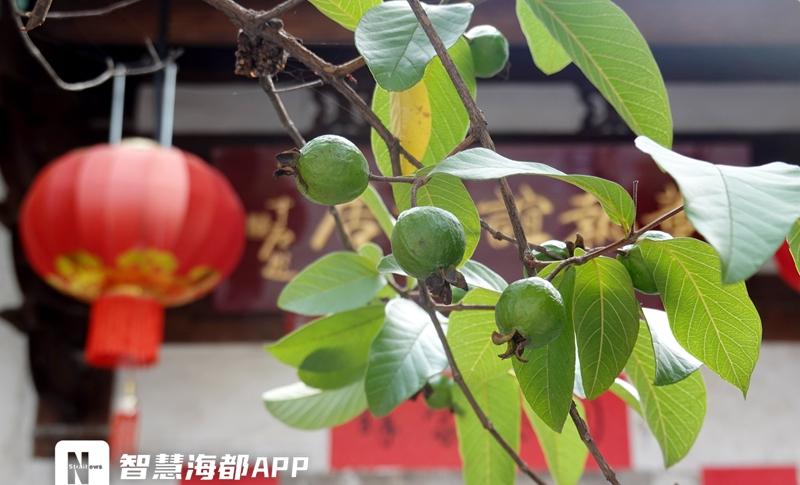N Haidu all-media reporter Luo Danling Bao Huawen/photo
Entering the autumn festival, many fruits will be listed, which is also the season when guava fruits are fragrant. One of the most famous guava trees in Fuzhou is located in front of the former residence of Dong Zhiyi on Nanhou Street in the Sanfang Qixiang Block.

In the past two days, after the baptism of Typhoon Ruby, the blue fruits the size of eggs are dotted with branches, making many passing tourists salivate.
Did you know that some people call soft and sticky guava fruit? Guava and pomegranate are both imported, how are they different? Today's "Talking about Heaven and Earth", let us answer them one by one.
Native to South America
Cross the ocean to Fujian
Hearing the name guava, you might guess that its country of origin is not in China. Indeed, according to research, the home of guava is in Latin America in the Western Hemisphere. In the 16th century, after the opening of the Great Navigation Age, Spanish and Portuguese navigators brought it to the Philippines, and soon this fruit also came to China and became a common fruit in South China.
The guava in front of Dong Zhiyi's former residence in Nanhou Street is full of leaves and fruits
Although this guava tree in Nanhou Street is not an ancient tree, it has vigorous branches and lines full of vicissitudes, which complement the saddle wall of Dong Zhiyi's former residence.
In the sunlight, the turquoise fruits of the trees also look crystal clear and lovely. Not only that, but its oval leaves will also emit a special fruity fragrance, refreshing and refreshing.
Fruit the size of an egg hangs from the branches
The place where guava is planted in Fuzhou is not only in Nanhou Street, but also in Minjiang Park, Yantaishan Historical and Cultural Block, and even behind the front house in the countryside of Minhou.
Garden experts speculate that guava entered Fujian a hundred years ago.
Guava and pomegranate are close relatives
But it is called fruit
Guava belongs to the guava genus of the myrtle family Myrtle, and the pomegranate belongs to the pomegranate genus of the myrtle family, and the two are close relatives. Guava has many nicknames, the more famous is Ballet.
The fruit is slightly smaller than an egg
So, what is the difference between guava and pomegranate? According to reports, the main difference between the two is the fruit.
The Flora of China records that the berries of guava are spherical, oval or pear-shaped, 3 to 8 cm long, with sepals at the apex, white and yellow flesh, and most of the seeds. Because the fruit of the guava rots, it looks like a lump of, so it has another name for fruit.
The berries of pomegranate are nearly spherical, 5 to 12 cm in diameter, usually yellowish brown or pale yellowish green, sometimes white, and faint purple. Most of the seeds are fleshy outer seed coats that are edible.
It is said that a guava tree can grow up to 15 meters. In contrast, the pomegranate tree is much shorter, and the ordinary pomegranate is only 3 to 5 meters tall.
If it is in the spring, you will also find that the flowers of the two plants are very different. The flowers of pomegranate, depending on the variety, come in red, yellow and white colors, while the guava flowers are white.
Also an imported object, pomegranates have a longer history of cultivation in China, and it is said that they entered China in the Han Dynasty. In Fuzhou's earliest surviving Fang Zhi - Song "Chunxi Three Mountains Chronicle", pomegranates are also mentioned, and the book writes: "Pomegranates, there are yellow and red colors, near there are also white ones, real and sweet, two kinds of sour, sweet for the fruit, and the one who is drunk into medicine." ”
Tip: Look at Chakra
Three steps to pick out good pomegranates
The fruit of the pomegranate tastes sour and sweet, juicy and refreshing, but some people "turn it away" because it is very troublesome to eat. In fact, as long as you use the right method, you will definitely fall in love with eating pomegranates.
First, use a fruit knife to cut a hexagonal, square, or rectangular opening on top of the pomegranate, making sure to scratch where the pomegranate seeds can be seen. Then, according to the cut, use a fruit knife to cut from the top to the bottom. Finally, with a little force along the stroke, open the pomegranate to see the fruit.
So, how do you pick a good pomegranate?
It's very simple, look, check, sweep, three steps can be. The so-called look, is to see the gloss, usually, the skin smooth, shiny pomegranate is the freshest, there are dark spots do not buy; check is to see the peel, fresh, ripe pomegranate skin and flesh is very full, tight, loose skin, wrinkled pomegranate, then the quality is poor, do not buy the skin has obvious scratches of the pomegranate;
Editor: Pan Zeyan